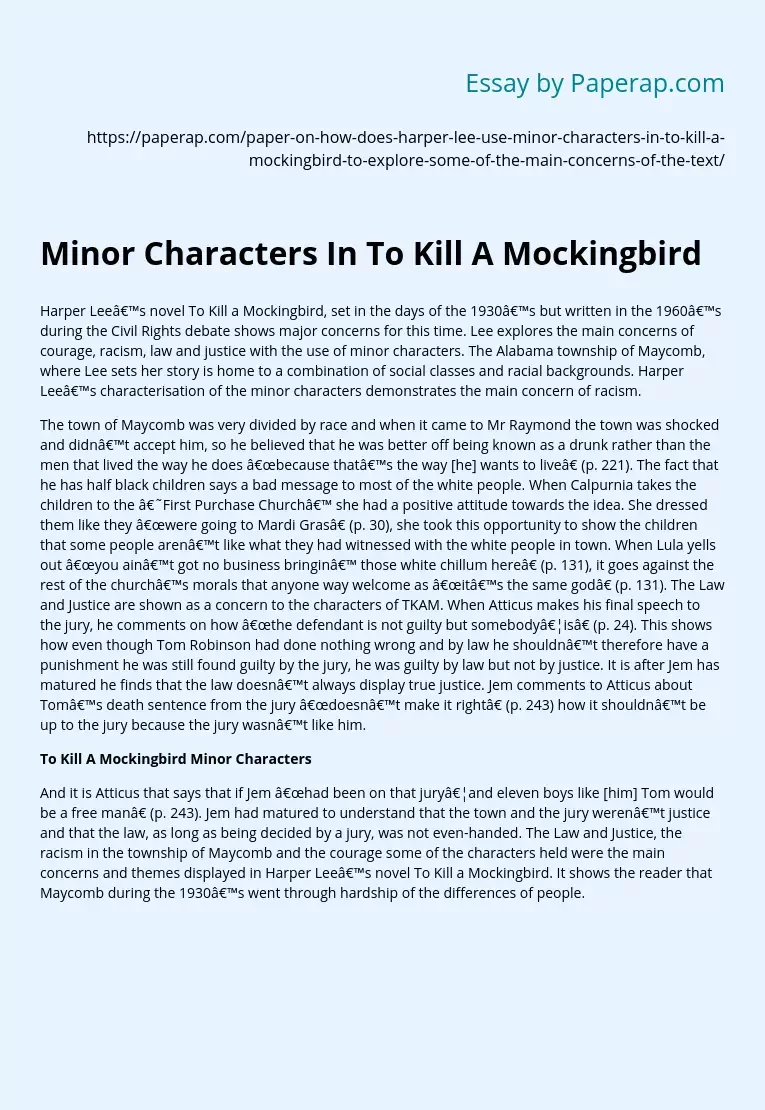Minor Characters In To Kill A Mockingbird
Harper Lee’s novel To Kill a Mockingbird, set in the days of the 1930’s but written in the 1960’s during the Civil Rights debate shows major concerns for this time. Lee explores the main concerns of courage, racism, law and justice with the use of minor characters. The Alabama township of Maycomb, where Lee sets her story is home to a combination of social classes and racial backgrounds. Harper Lee’s characterisation of the minor characters demonstrates the main concern of racism.
The town of Maycomb was very divided by race and when it came to Mr Raymond the town was shocked and didn’t accept him, so he believed that he was better off being known as a drunk rather than the men that lived the way he does “because that’s the way [he] wants to live” (p. 221). The fact that he has half black children says a bad message to most of the white people. When Calpurnia takes the children to the ‘First Purchase Church’ she had a positive attitude towards the idea.
She dressed them like they “were going to Mardi Gras” (p. 30), she took this opportunity to show the children that some people aren’t like what they had witnessed with the white people in town. When Lula yells out “you ain’t got no business bringin’ those white chillum here” (p. 131), it goes against the rest of the church’s morals that anyone way welcome as “it’s the same god” (p. 131). The Law and Justice are shown as a concern to the characters of TKAM.
When Atticus makes his final speech to the jury, he comments on how “the defendant is not guilty but somebody…is” (p. 24). This shows how even though Tom Robinson had done nothing wrong and by law he shouldn’t therefore have a punishment he was still found guilty by the jury, he was guilty by law but not by justice. It is after Jem has matured he finds that the law doesn’t always display true justice. Jem comments to Atticus about Tom’s death sentence from the jury “doesn’t make it right” (p. 243) how it shouldn’t be up to the jury because the jury wasn’t like him.
To Kill A Mockingbird Minor Characters
And it is Atticus that says that if Jem “had been on that jury…and eleven boys like [him] Tom would be a free man” (p. 243). Jem had matured to understand that the town and the jury weren’t justice and that the law, as long as being decided by a jury, was not even-handed. The Law and Justice, the racism in the township of Maycomb and the courage some of the characters held were the main concerns and themes displayed in Harper Lee’s novel To Kill a Mockingbird. It shows the reader that Maycomb during the 1930’s went through hardship of the differences of people.
Minor Characters In To Kill A Mockingbird. (2019, Dec 05). Retrieved from https://paperap.com/paper-on-how-does-harper-lee-use-minor-characters-in-to-kill-a-mockingbird-to-explore-some-of-the-main-concerns-of-the-text/

